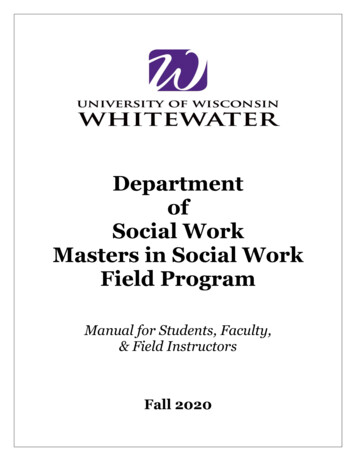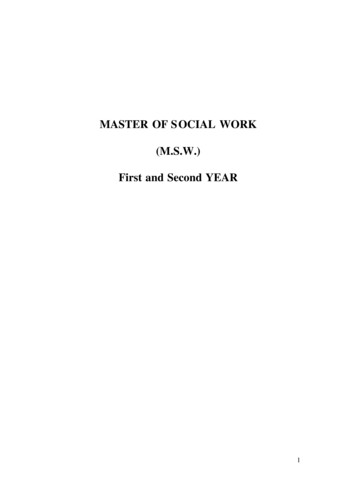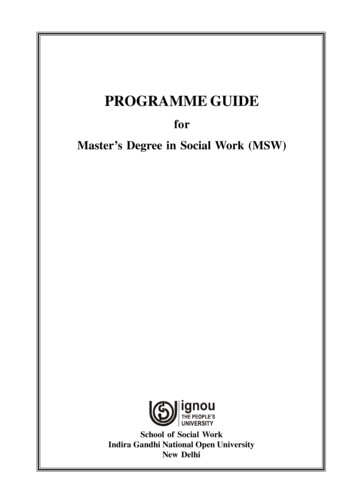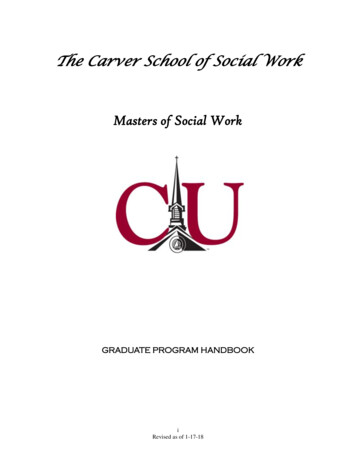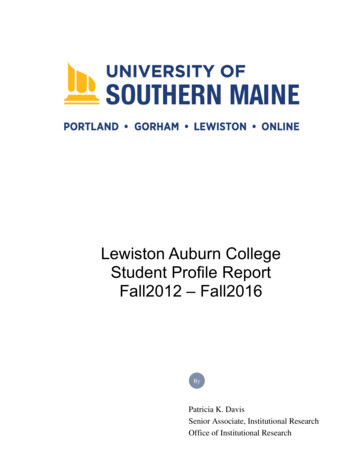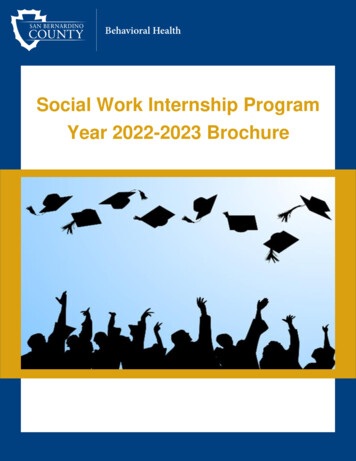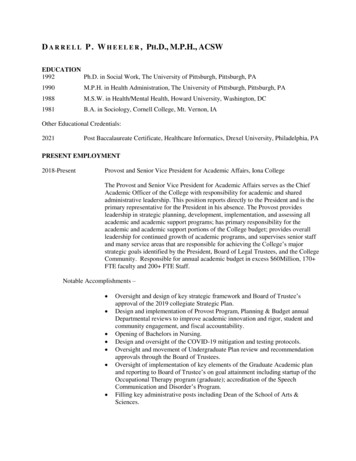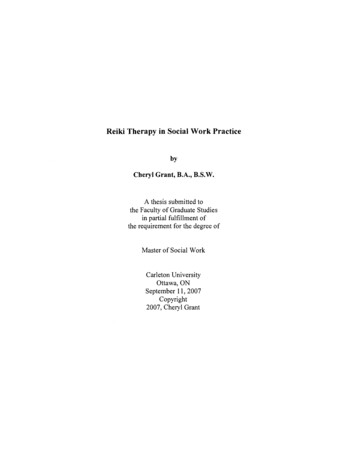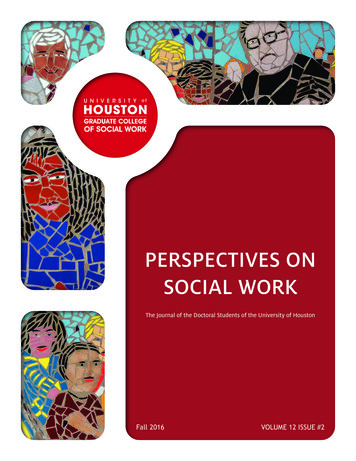
Transcription
PERSPECTIVES ONSOCIAL WORKThe Journal of the Doctoral Students of the University of HoustonFall 2016VOLUME 12 ISSUE #2
Perspectives on Social WorkEditorRebecca L. MauldinEditorial BoardTamara Al RawwadFlor AvellanedaLiza Barros LaneXin ChenMaurya GlaudeKenya MinnottRichard WagnerAnn WebbExternal ReviewersKathryn ArnettUniversity of PennsylvaniaNatasha BreinUniversity of TorontoAnnie M. FrancisUniversity of North Carolina atChapel HillJamie HatzisAdelphi UniversityHelen JiangUniversity of DenverAndrea JosephUniversity of PittsburghI-Hsuan LinIndiana UniversityAntoine LovellFordham UniversitySara Makki AlamdariIndiana UniversityLauren McInroyUniversity of TorontoTheresa MoranFordham UniversityMary PriesterUniversity of South CarolinaRusty SouleymanovUniversity of TorontoAbigail WilliamsUniversity of MichiganFaculty SponsorSheara Williams Jennings, PhD
Table of Contents2EditorialRebecca L. MauldinPerspectives on Social Work Awards3Medication Assisted Treatment: Experiences From the FieldMichael Gearhart, Case Western Reserve UniversityLacey Caporale, Case Western Reserve UniversityMargaret Baughman Sladky, Case Western Reserve UniversityMark I. Singer, Case Western Reserve UniversityMadison Wheeler, Case Western Reserve UniversityPaul Tuschman, Case Western Reserve University4Fostering a Developmental Perspective in Understanding Youth HomelessnessJennifer M. Frank, Bryn Mawr College12Clients and Students: Reflections on the Parallels Found Between DirectSocial Work Practice and Social Work EducationMonica Himes, University of Kentucky22An Analysis of Texas’ Bullying Policies & PracticesScott Sainato, University of Texas at Arlington29Reflections on the Scientist-Practitioner Model in Social Work DoctoralEducationSarah Ascienzo, University of Kentucky39The CV Builder49
EDITORIAL – Perspectives on Social Work: A community affairAt Perspectives on Social Work, our primary mission is to provide opportunities for students toenhance scholarly skills in writing, editing, and gain exposure to the publication process. When Ibecame editor of the journal this fall, I found myself questioning why the primary mission wasn’tmore related to the practice social work itself. However, as the semester unfolded and Iencountered more decisions to make on behalf of the journal, I came to fully embrace thismission as our guiding star. Building scientific knowledge is collaborative enterprise and themany roles students play in this journal are imperative for its success. Yet as students, we mustlearn the skills to write quality scholarly manuscripts, provide thorough reviews, and navigatethe publication process. I’ve come to realize that a student-run journal that showcases studentwork provides a welcoming environment for skill development. At PSW, the editorial staff iscommitted to the professional development of our authors. Not only do we receive satisfactionfrom helping our fellow doctoral students, we are beneficiaries of lessons about writing andpublication in our roles. To me, this giving and receiving is the foundation of community and Iam proud of the role PSW is playing in community-based competence building (Johnson et al.,2014).With this in mind, we are in the process of making several changes in our operations. As you willnotice on the following page, we have initiated awards for articles and reviewers. These awardsallow us to recognize our community members who have dedicated time and energy toproducing the science of social work. The winning authors help set a standard of excellence inPSW articles. Our reviewers make each article published better, help all of our authors improve,and make the work of the journal possible. Our top reviewers are students we have relied uponfor their willingness to accept assignments as well as their timely and insightful reviews. Inanother effort to acknowledge our reviewers, we have begun collaborating with Publons(www.publons.com) to provide them with recognition of their contributions to the journal.In the upcoming months, we will be introducing further changes that we hope will enhance thejournal and continue to develop skills and a sense of community among the students involved inthis collaborative effort. In my role as editor, I aim to help build a community where supportiveand collegial student scientists come receive knowledge and skills while share their gifts andtalents with others.Rebecca L. Mauldin, LMSWUniversity of HoustonEditorReferencesJohnson, W. B., Barnett, J. E.; Elman, N. S.; Forrest, L., Schwartz-Mette, R, & Kaslow, N. J. (2014).Preparing trainees for lifelong competence: Creating a communitarian training culture. Training andEducation in Professional Psychology, 8(4), 211-220. doi: 10.1037/tep0000048
Perspectives on Social Work AwardsBest Empirical Article - 2015Prock, K. A., Cummings, C. E., DeNuccio, A., Hindes, K. L., & Hughes, A. K. (2015). SocialWorkers’ Perceptions of Working with People who have HIV/AIDS. Perspectives on SocialWork, 11(2), 14-25.Kristen A. Prock is a doctoral student in the School of Social Work Michigan State University. She earned herMSW at Indiana University-South Bend, and her Bachelor of Arts in Psychology at University of WisconsinEau Claire. Her research interests include victimization of vulnerable populations, with a specific focus onhomeless youth who identify as LGBT, services provision within homeless youth shelters, and violence againstwomen.Cristy E. Cummings is a doctoral student at the Michigan State University School of Social Work. She earnedher MSW and her Bachelor of Arts in Women’s Studies from Indiana University South Bend. Her researchinterests are broadly in the areas of gender and sexuality, with her current work focusing on both female andmale survivors of sexual assault, especially related to help-seeking behaviors and access to services.Alec DeNuccio is a master’s student in the School of Social Work at University of Michigan. He earned hisBASW from Michigan State University in May 2016. Alec is interested in macro level practice and communityorganizing.Kailey L. Hindes completed her BASW at Michigan State University in May 2016, and is currently working inwith foster care youth. Her research interests include social work attitudes and care transitions in olderadults.Anne Hughes is an associate professor in the School of Social Work at Michigan State University. She earnedher PhD from the University of Maryland, Baltimore. Her research interests include aging and health, with afocus on improving care for frail or vulnerable older adults. She is a John A. Hartford Foundation FacultyScholar in Geriatric Social Work.Best Non-empirical Article - 2015Lateef, Husain. (2015). Afrocentricity theory revisited: An alternative framework forassisting Black youth. Perspectives on Social Work, 11(2), 26-31.Husain Lateef is a current doctoral student in the School of Social Work at Arizona State University. Heobtained his MSW from the University of Michigan and his BA from Morehouse College in Atlanta, GA.Currently, his research focus is exploring positive development among African American youth.Best Reviewers2014 – 2015: Andrea Joseph, University of Pittsburgh2014 – 2015: Katherine Williams, Loyola University Chicago2015 Honorable Mention: Cole Hooley, Washington University
Medication Assisted Treatment: Experiences from the FieldMichael Gearhart, MSSA, Lacey Caporale, MA, MargaretBaughman Sladky, PhD, Mark I. Singer, PhD, MadisonWheeler, and Paul TuschmanCase Western Reserve UniversityCorrespondence concerning this article should be addressed to Michael Gearhart, 1810 E. 22nd St., Apt.3206, Cleveland, OH 44114. Email: mxg370@case.eduFunds for this project were provided by the Ohio Department of Mental Health and Addiction Services,“Ohio Addiction Treatment Pilot Program.” 2013-2015.AbstractThe use of heroin and other opiates has increased considerably in recent years with many usersbecoming involved with the criminal justice system. Because of this growth, the use ofmedication assisted treatment is becoming increasingly popular in courts that specialize in opiateaddictions. This paper analyzes the experiences of treatment teams in courts that specialize inproviding medication assisted treatment. Overall, perceptions of medication assisted treatmentwere positive although service providers identified some limitations. Recognizing the benefitsand limitations of medication assisted treatment is useful for social work practice that focuses onopiate addictions because heroin use continues to rise.Keywords: medication assisted treatment, opiate addiction, drug courtsIntroductionA recent Substance Abuse and Mental Health Services Administration (SAMSHA) report statesthat there were over 600,000 heroin users aged 18 and older in 2013, and rates of heroinoverdose deaths have nearly doubled between 2011 and 2013 (Hedegaard, Chen, & Warner,2015; SAMSHA, 2014). In an attempt to curb the use of opiates and heroin, several states haveenacted laws to monitor the sales of prescription drugs (Centers for Disease Control andPrevention, 2015). Given the increase in opiate use, and the emphasis on policing the sales ofopiates, a growing proportion of individuals are being arrested for opiate use or crimes related toopiate use, e.g., trafficking, thefts committed to obtain drugs (Jones, 2013; Office of NationalDrug Control Policy, 2014) with 98% of drug courts serving at least one opiate addicted client(Matusow, 2013).In response to this growth, criminal justice agencies are developing medication assistedtreatment (MAT) programs to treat individuals with opiate addictions (Lee & Rich, 2012). A 2017 Perspectives on Social Work
Gearhart et al., MEDICATION ASSISTED TREATMENT5recent nationally representative survey found that 56% of drug courts provided any MAT(Matusow et al., 2013) and MAT is becoming increasingly popular in courts that specialize inalcohol and opiate addictions (Lee & Rich, 2012; Nunn, Zaller, Dickman, Trimbur, Nijhawan, &Rich, 2009; Volkow et al., 2014). MAT utilizes medications in conjunction with treatmentservices to address alcohol and opiate addictions, e.g., heroin, morphine, oxycodone (Volkow,Frieden, Hyde, & Cha, 2014). The medications used for MAT bind to the same receptors thatare activated during both alcohol and opiate use, but each medication has different mechanismand effects (for a discussion on mechanisms and effects of MATs see Connery, 2015). It isimportant for social workers to learn about MAT because they are being implemented by morecourts and social workers work in many systems where MAT can be used such as court systems,drug treatment centers, hospitals, and mental health treatment centers.MethodsTo address the number of opiate related arrests the state of Ohio created a pilot program thatoffered MAT to offenders with opiate and/or alcohol addictions (Baughman Sladky, Singer,Gearhart, Tuschman, 2015). The program took place in 10 courts across seven counties. Eachcourt had a multidisciplinary core team that included court coordinators, service providers,probation officers, and court staff. Although each court had its own requirements for graduation,the MAT court process typically lasted between one and two years. These courts offered anarray of services that varied by location, and included case management, substance use andmental health counseling, dual disorder treatment, and anger management among others. Allcourts received funding to provide MAT to clients.Focus groups were conducted with treatment teams at nine of the ten courts because one courtwithdrew from the pilot program. Data for this study were obtained from the notes of thesefocus groups. A total of 53 individuals participated in the focus groups. Most participants(60.4%, n 32) were affiliated with a treatment provider (e.g., counselor, aftercare specialist), 13(24.5%) were affiliated with the courts (e.g., court coordinator, assistant prosecutor), and eight(15.1%) were from the probation department. Researchers analyzed the data using a groundedtheory approach to understand how MAT impacted the treatment process (Cresswell, 2013). Forthis study, one researcher created open, axial, and selective codes, and coded the interviews. Theresearch team then discussed and reached consensus about the codes. Emergent themes fromfocus groups are described in the following sections. All data collection procedures wereapproved by Case Western Reserve University’s institutional review board.Key ThemesDeciding to Use MATAlthough each court had their own procedures for informing clients about MAT, the decision ofwhether or not to use MAT was left to the discretion of the client. Courts relied on medical staffand/or a counselor or therapist to help clients make decisions about MAT. In one court, a judgestated that a particular medication was not available to clients because it could be sold as anarcotic. Most courts (88.8%, n 8) stated that clients were on medications for 10 to 12 months.The decision to discontinue MAT use was also left to the discretion of the client. In very fewcases clients chose to stop using MAT because of side effects. Each site reported anywhere from
6Perspectives on Social Work, Volume 12, No. 2one to four clients who experienced side effects that commonly included anxiety, nausea,changes in appetite, restlessness, and headaches. Typically, the reported side effects hadrelatively little to do with the medications and more to do with discontinued opiate use. In thewords of one focus group participant, “One guy said he thought [the medication] messed up hisknee but he had an abscess he wasn’t aware of because he was on opiates and didn’t know.” Allfocus groups agreed that the side effects typically dissipated after a few days.Early Discontinuation of MATIn nearly all courts (88.8%, n 8), clients typically chose to discontinue medication use earlierthan the pharmaceutical companies recommended. Focus group participants stated that clientswanted to stop using medications with continued support from the treatment team. However,treatment teams stated that, “Those that relapsed chose to stop medication three months prior tograduation,” and discontinuing medication use early was “probably not in their best interest.Some people stop at 12 months, others at nine months. The time they stop is a risk factor.” Onefocus group participant stated, “It seemed like a lot of participants would complete court fasterand then relapse shortly after they stopped taking medication.”Clarity, Mental Health, and TraumaThe most common theme in terms of the benefits of MAT was clarity, which was mentioned 19times in focus groups. As one focus group participant described:Clarity. I would say that the biggest thing is mental clarity. They make better decisions.They’re more willing – they’re easier to work with. They’re more willing to do the thingsthat we are asking of them because they are thinking more clearly.Focus group participants stated that “[clients’] brains quiet down” and “the obsession andcompulsion of the cravings is not there.” One probation officer described how clients could notget a job or support their family because they could not stop using opiates before receivingMAT. With MAT, clients cannot get high and can dedicate more time to finding a job, going totreatment and ultimately meet the conditions of probation. A counselor quoted a client as saying,“I don’t go to bed thinking about it [using] and it’s not the first thing in my mind when I wakeup.”According to the focus groups, the ability to think clearly is an important benefit of MAT. Asone clinician pointed out:In my experience it’s about three months before they lift their head out of the fog and seeclearly where they’ve been. Then there’s often a reason they even get into addiction. It’sdue to mental health issues, trauma, family issues there’s issues you work for eachindividual. For some it might be family, for others it might be mental health/traumahistory.Mental health and trauma were two issues that were prevalent in the MAT program. Onetreatment provider shared stories about clients that were demonstrating symptoms of mentalhealth issues at intake. Once the clients started MAT, service providers were able to disentanglehow much of the clients’ symptomatology was due to substance use versus mental health issues
Gearhart et al., MEDICATION ASSISTED TREATMENT7and in some cases, the mental health symptoms dissipated. In other cases, clients were able toseek help for mental health issues. Trauma was frequently cited as a cause for clients’ mentalhealth issues. In the words of one clinician, “Trauma needs to be addressed. It plays a huge rolein their behavior Recognizing the trauma has made a huge difference in their lives. It makesthem more prepared to live in the community successfully.”MAT was seen as an important piece of the treatment process because, “[clients] slow down.The MAT lets us talk about family issues, history, accountability, responsibility.” Cliniciansreported higher engagement in treatment and stated that clients can “really focus on treatmentissues,” while a probation officer stated that their clients can “live their lives while workingthrough addiction,” and ultimately “comply with the court process.”MAT as One Component of TreatmentFocus group participants also recognized that “addiction is physical, but it’s also highly mental.The mental is what you fight the rest of your life.” Although MAT serves as a springboard tohelp clients in treatment, it will only work “as effectively as the person allows it to be in helpingthem become members of the community.” One substance use counselor made the followingsummation:MAT may take them from their cravings, but their lifestyle we can’t change. HonestlyMAT isn’t going to be as effective. For people willing to make a change MAT givesthem an opportunity to get their mind right if you will, and let talk therapy and other toolsto have their impact.Further, focus group participants stated that “MAT isn’t going to change lifestyle” and clients are“returning to the same systems in an attempt to stand strong and firm, and the challenge is stillthere.” Although MAT is a useful tool, all it does is reduce the severity of cravings and removethe ability to get high on opiates. The goal of MAT is to take advantage of these properties andhelp clients develop skills to remain sober in their local environments. However, based on focusgroup feedback, MAT alone cannot meet the needs of an individual.Relapse and OverdoseAccording to the focus groups, relapse while on medications was rare throughout the MAT courtprogram. The most commonly used substance for relapse was alcohol, which was reported byseven (77.7%) of the court teams. Although the medications prescribed for MAT are used foropiate and/or alcohol addiction, focus groups debated if this was appropriate. Some stated thatMAT prevented clients from getting drunk; others stated that clients got drunk quicker or at thesame rate as without MAT. Still others said that “alcohol works in a different way, physicallythey’re feeling it but mentally they aren’t so it isn’t until you’re on [drink] 33 that it hits you.”One focus group participant asserted that they would not treat alcohol addictions with MAT.Because clients don’t get as high as quickly as they normally would on alcohol or opiates, thereis a risk that clients will use more of the substance in an attempt to achieve the same effect andoverdose. One focus group participant described a situation where “one person challenged MATwith Percocet. They took three and got no effect and got scared at the risk of overdose.”
8Perspectives on Social Work, Volume 12, No. 2Skepticism towards MATAlthough overall perceptions of MAT were positive, focus group members reported earlyskepticism pertaining to the use of MAT. As one respondent noted, “One of the biggestchallenges was—even though there was great communication between probation andtreatment—there was a lot of—we needed to build the trust in MAT, period. I think we haveover time.” Skepticism towards MAT was not limited to the court program staff however. Asignificant barrier to starting MAT programs in some courts was:probably trying to get the entire community all on board. I would suggest that there arequite a few people that aren’t – I wouldn’t say unhappy with it, but probably areskeptical. I would assume those people aren’t believers in treatment [referring to MAT].One substance use counselor stated that clients were met with resistance at treatment groupsbecause, “old timers believe you’re substituting another drug for the one you’re using. Peoplewith MAT continue MAT even though old timers say you should be off it.”Challenges to ImplementationIn addition to the skepticism about MAT’s effectiveness, focus groups discussed challenges toproviding MAT. There was little consistency across sites in terms of the challenges experienced.The most commonly discussed challenge was detox, which was discussed in four of the ninefocus groups (44.4%). Detox is an important component of MAT because clients need tomaintain a seven to 14 day period of sobriety before starting MAT. One focus group participantstated that having clients detox and then administering the medication is “impossible to do unlessthey are in residential.” Another issue was using jail as a detox facility. One focus groupparticipant was against using jail as a detox facility and stated that the greatest need for theircourt was “a rapid detox facility that is a closed door facility so we can do humane detox insteadof a jail cell with a hot shower.” Another theme that emerged was the importance of the servicesin the surrounding community. One focus group reported challenges because there was only oneprovider of MAT in the county. Participants in another focus group stated that recovery groupslike Alcoholics Anonymous and services for needs like employment were scarce, so clients didnot have many supports outside of the court program.LimitationsThere are multiple limitations worth noting. Researchers were only able to conduct interviewswith court teams and were not able to interview program participants. In terms of analysis, oneresearcher was responsible for the coding and there was no member checking. Further, thefindings reflect the experiences of ten courts in one state and may not generalize to all courts thatprovide MAT. Researchers also cannot determine what other services courts provided inaddition to MAT.DiscussionFocus group participants agreed that MAT is a useful tool for treatment, but there are limits to itseffectiveness. Questions were raised in terms of the effectiveness of MAT for addressing alcoholuse. Not only does this highlight an important area for future research, but social workers may
Gearhart et al., MEDICATION ASSISTED TREATMENT9also need to build in additional supports that target alcohol use when working with clients onMAT. The findings also illustrate the importance of education about relapse. Although relapseprevention is an important goal of treatment, there is an elevated importance placed on the risk ofoverdosing for clients that are on MAT because clients are likely to take more of a substance inan attempt to get high.Social workers are in a position to capitalize on the benefits of MAT like suppressing the urge ofcravings, eliminating the ability to get high, and improving mental clarity. This allowspractitioners to use their clinical skills to disentangle and address the complex relationshipsamong substance use, mental health, and trauma as well as provide services that address the rootcauses of clients’ addictions. Social workers are also able to identify clients who may requireservices that are not part of the standard drug court services like motivational interviewing,trauma informed care, and integrated dual disorder treatment.Social workers can also be involved in the discussion of how to more successfully blendtreatment and court processes. Focus groups identified a need to build a bridge to MAT thatinvolves detoxing in a location that is humane and facilitates a smooth transition from detox toreceiving MAT. Drug courts using MAT may also need to examine how to more successfullyblend treatment and court processes with the recommended guidelines of the medications used intreatment. Social workers may also find MAT guidelines useful for planning termination becausethe time an individual discontinued MAT use was regarded as an important risk factor forrelapse. Further, clients wanted to transition off of MAT while still receiving direct services,which illustrates that services are an important part of this transition. Therefore, social workerscan play an important role in developing methods of transitioning clients off of MAT to preventrelapse after treatment.Another important step for MAT programs is raising awareness and educating members of thetreatment community about what MAT is and why individuals on MAT can still be consideredsober because clients are taking medications as prescribed (The Betty Ford Institute Consensus,2007). Social workers are a valuable educational asset in this regard because they span multiplesystems that interact with individuals using MAT.Focus group participants reached a consensus that the impact of MAT was ultimately positiveand outweighed the risks associated with the medications. However, MAT is best used as asupplement to effective practice. Understanding the strengths and limitations of MAT can betterinform social work practice that incorporates MAT.ReferencesBaughman Sladky, M., Signer, M. I., Gearhart, M. C., & Tuschman, P. (2015). Ohio MHASAddiction Treatment Pilot Program. Cleveland, OH: Dr. Semi J. and Ruth W. Begun Centerfor Violence Prevention, Research, and Education.Center for Disease Control and Prevention, Office for State, Local, and Territorial Support.(2015). Prescription drug time and dosage limit laws. Public Health Law. 1-10.
10Perspectives on Social Work, Volume 12, No. 2Connery, H. S. (2015). Medication-assisted treatment of opioid use disorder: Review of theevidence and future directions. Harvard Review of Psychiatry, 23, 63-75. doi:10.1097/HRP.0000000000000075.Creswell, J. W. (2013). Qualitative inquiry and research design: Choosing among the fiveapproaches, 3rd Edition. Thousand Oaks, CA: Sage Publications.Hedegaard H., Chen L. H., & Warner, M. Drug-poisoning deaths involving heroin: UnitedStates, 2000–2013. Hyattsville, MD: CDC, National Center for Health Statistics; 2015.NCHS data brief no. 190.Jones, C. M. (2013). Heroin use and heroin use risk behaviors among nonmedical users ofprescription opioid pain relievers—United States, 2002-2004 and 2008-2010. Drug andAlcohol Dependence, 132, 95-100. doi: 10.1016/j.drugalcdep.2013.01.007.Lee, J. D., & Rich, J. D. (2012). Opioid pharmacotherapy in criminal justice settings: Now is thetime. Substance Abuse, 33, 1-4. doi: 10.1080/08897077.2011.616797.Matusow, H., Dickman, S. L., Rich, J. D., Fong, C., Dumont, D. M., Hardin, C., Marlowe, D., &Rosenblum, A. (2013). Medication assisted treatment in US drug courts: Results from anationwide survey of availability, barriers and attitudes. Journal of Substance AbuseTreatment, 44, 473-480. doi: 10.1016/j.jsat.2012.10.004.Nunn, A., Zaller, N., Dickman, S., Trimbur, C., Nijhawan, A., & Rich, J. D. (2009). Methadoneand buprenorphine prescribing and referral practices in US prison systems: results from anationwide survey. Drug and alcohol dependence, 105(1), 83-88. doi:10.1016/j.drugalcdep.2009.06.015.Office of National Drug Control Policy. (2014). 2013 Annual Report, Arrestee Drug AbuseMonitoring Program II. Washington, DC: Executive Office of the President.Substance Abuse and Mental Health Services Administration. (2014). Results from the 2013National Survey on Drug Use and Health: Summary of National Findings. NSDUH Series H48, HHS Publication No. (SMA) 14-4863. Rockville, MD: Substance Abuse and MentalHealth Services Administration.The Betty Ford Institute Consensus. (2007). What is recovery? A working definition from theBetty Ford Institute. Journal of Substance Abuse Treatment, 33, 221-228. doi:10.1016/j.jsat.2007.06.001.Volkow, N. D., Frieden, T. R., Hyde, P. S., & Cha, S. S. (2014). Medication-assisted therapies—tackling the opioid-overdose epidemic. New England Journal of Medicine, 370, 2063-2066.doi: 10.1056/NEJMp1402780.
Gearhart et al., MEDICATION ASSISTED TREATMENT11Michael Gearhart is a doctoral candidate at the Jack, Joseph and Morton Mandel School ofApplied Social Sciences. He currently works as a research assistant at both the Dr. Semi J. andRuth W. Begun Center for Violence Prevention, Research and Education; and the NationalInitiative on Mixed Income Communities. His research seeks to understand the processes bywhich communities mobilize to address social issues including neighborhood disorder, healthdisparities, crime and juvenile delinquency.Lacey Caporale is a third year sociology PhD student at Case Western Reserve University. Shereceived her MA in sociology from Cleveland State University in 2012. Her research interestsinclude gentrification, urban displacement, poverty and inequality, human rights, and healthdisparities. She is a Managing Editor for Societies Without Borders, a human rights and socialscience journal. Ms. Caporale is currently conducting research in a neighborhood of Clevelandexperiencing gentrification, using ethnographic and life story methods.Margaret Baughman-Sladky is a Senior Research Associate at the Begun Center for ViolencePrevention Research & Education at Case Western Reserve University’s Jack, Joseph, andMorton Mandel School of Applied Social Sciences.Mark I Singer is the Leonard W. Mayo Professor of Family and Child Welfare at the MandelSchool of Applied Social Sciences, Case Western Reserve University. He is currently the deputydirector of the Semi J. and Rut
EDITORIAL - Perspectives on Social Work: A community affair At Perspectives on Social Work, our primary mission is to provide opportunities for students to enhance scholarly skills in writing, editing, and gain exposure to the publication process. When I became editor of the journal this fall, I found myself questioning why the primary mission wasn't
